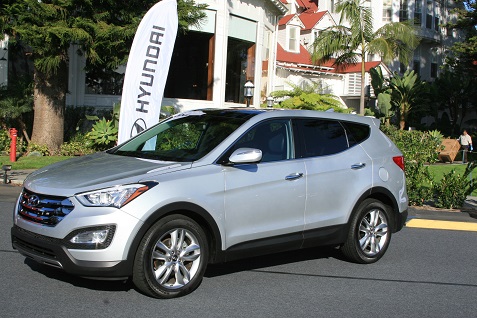First Drive: 2013 Hyundai Santa Fe GSL and Limited
Hyundai introduced a two-wheelbase strategy for the completely new Santa Fe for the 2013 model. I tested the 5-passenger Sport model last year, and then had the opportunity to test drive the 7-passenger Santa Fe GSL and the 6-passenger Santa Fe Limited recently in San Diego.
The Sport model has been a hit so far, which isn’t a surprise given how much I liked the vehicle. In the six full months since the new model launch, retail sales for the vehicle have increased over 37%. Now the larger version with three rows is hitting showrooms as well. The GSL fits seven passengers while the Limited features captain chairs in the second row with a capacity for six passengers.
Exterior
The GSL and Limited look very similar to the Sport model, with the major difference being the lines for the rear side windows being softened in the larger wheelbase models. As I noted in the Sport review, “Hyundai continues to implement its “Fluidic Sculpture” design principles that have given Hyundai vehicles a bold and distinctive look. Specifically, the Santa Fe features a new design concept called Storm Edge, which captures the strong and dynamic images created by nature during the formation of a storm.” I like the idea of keeping the Santa Fe name across both the compact and midsize CUV models, as the design work well across both platforms. I like the front end in particular, and the rest of the design flows nicely from there.
Interior
The choice of a bench seat for the second row and two captain’s chairs offers nice flexibility for consumers. The captain’s chair offer a comfortable and roomy experience in the second row. And while there’s adequate room in the third row, there isn’t a ton of headroom there for larger adults so that third row is best used for kids. The split-folding third row seats offer very nice cargo flexibility for families and for road trips. The second row captain’s chair also fold down and then the second row bench in the GSL offers a 40/20/40 split folding option. The overall versatility is excellent.
The comfort and styling of Hyundai’s interiors have been impressive and the Santa Fe is no exception. I liked the design of the center stack as it offers a unique twist on what we often see. Hyundai offers a wide variety of option packages, so you can certainly get a loaded version that satisfies all your needs, but even the base models are stylish and very comfortable. I also liked the panoramic sunroof and heated steering wheel options in the technology package.
Performance
The power of the V6 engine in the GSL and Limited Santa Fe will grab your attention right away. When I test the Sport model I was impressed with the 2.0L Turbo 4-cylender engine, but I liked the easy power of the V6 even better. The responsiveness and acceleration were excellent and this vehicle is very fun to drive. The larger vehicle also handles nicely around corners given its size, and the six-speed automatic transmission performed flawlessly.
The Lambda II 3.3-liter GDI V6 engine is rated at 290 horsepower which is tied with the Explorer for the midsize CUV segment, and it’s the only midsize CUV with a standard direct injection V6 engine. Fuel economy is competitive at 18 city, 25 highway and 21 combined. From a safety point of view, all Santa Fe models feature seven airbags, including side curtain airbags and a driver’s knee airbag along with rollover sensors for the side curtain airbags.
Overview
Hyundai continues to put out hit after hit, and the entire Santa Fe line from the Sport to the GSL and Limited will fit into the lineup very well. With the different wheelbases and seating options, Hyundai will address the needs of most consumers looking for a CUV. Put this one on your test drive list.
You can follow us on Twitter and Facebook for content updates. Also, sign up for our email list for weekly updates and check us out on Google+ as well.
Posted in: Car Reviews, Cars
Tags: auto photos, auto slideshow, automobile photo gallery, autos, autos for guys, autos for men, car info for men, car photo gallery, car photos, car reviews, car slideshow, CUV, first drive, first drive automobile reviews, first drive car reviews, first drive reviews for guys, first drive reviews for men, Hyundai Santa Fe, midsize CUV, new automobiles, new autos, new cars, Santa Fe






















 You may wonder why I waited so long to take on this most popular of cocktails. I may wonder why. No, it’s not cocktail snobbery, although it’s true that the margarita hasn’t always been admitted to the most exclusive cocktail clubs.
You may wonder why I waited so long to take on this most popular of cocktails. I may wonder why. No, it’s not cocktail snobbery, although it’s true that the margarita hasn’t always been admitted to the most exclusive cocktail clubs.








